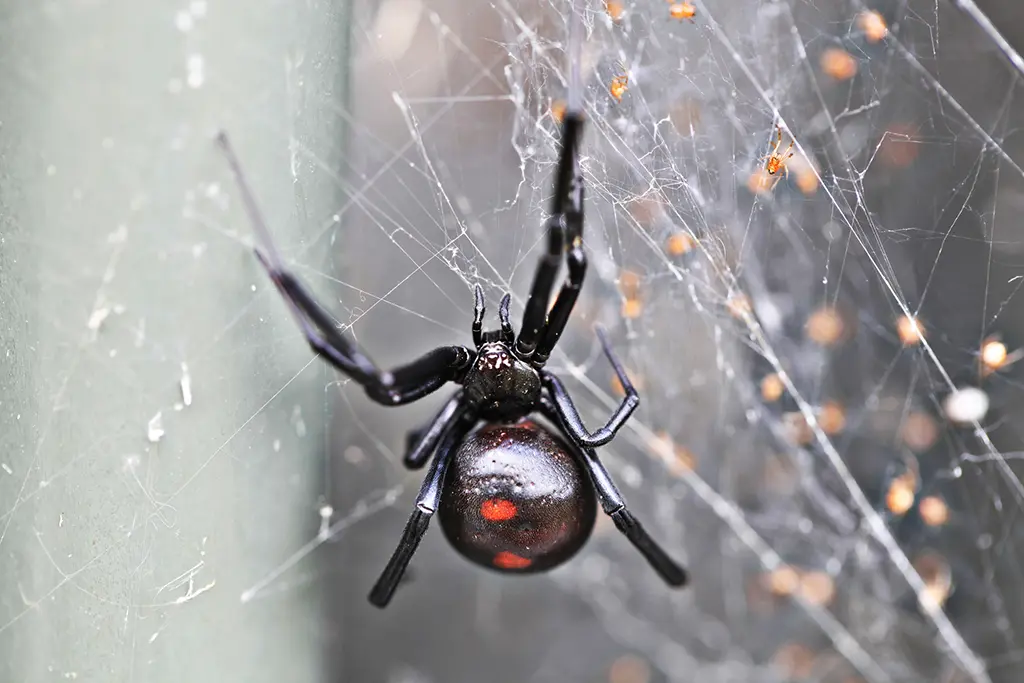Spiders
Get a free estimate

Spiders
The spider is a diverse group of arachnids that play important roles in ecosystems by controlling insect populations. While the vast majority of spider species are harmless to humans, some are venomous and can pose a threat. Remember that most spiders are harmless and play important roles in managing insect populations. While it’s good to be cautious around spiders, it’s also important not to overreact to their presence. If you’re uncertain about a specific spider, it’s a good idea to give Hannan Environmental Services a call for proper identification and guidance.
Black Widows
The Black Widow spider (Latrodectus spp.) are a venomous spider known for their distinctive appearance and potentially dangerous bites. They are found in various parts of the world, and several species exist. In the United States, the most well-known species is the western black widow (Latrodectus hesperus) and the northern black widow (Latrodectus variolus).
The female Southern black widow is a shiny black spider with a distinctive red hourglass on the abdomen. The Southern black widow has a complete hourglass, while the Western species’ hourglass can vary from two connected triangles to separated triangles to a minimum of barely visible red blotches. Female black widow spiders are usually larger than males, with a body length ranging from 0.5 to 1.5 inches (1.2 to 3.8 cm).
Black widows primarily feed on small insects such as flies, mosquitoes, beetles, and grasshoppers. They are known for their unique feeding behavior, as they wrap their prey in silk and inject digestive enzymes into the prey to liquefy the internal organs. They then suck up the resulting liquid.
Typical outdoor habitats in which spiders are often found include wood and rock piles, rodent burrows, and hollow tree stumps. Indoor habitats include outhouses, garages, sheds, and basements. In nature, most bites occur while reaching under an object that the spider inhabits such as a woodpile or stones. While working in or around areas of suitable habitat for these spiders, wearing gardening gloves can help prevent envenomation. Additionally, use caution when working in sheds and barns where spiders can be found.
Credit: https://entnemdept.ufl.edu/creatures/URBAN/SPIDERS/black_widow_spider.htm
Brown Recluse
Brown recluse spiders (Loxosceles reclusa) are another type of venomous spider found in certain regions of the United States. They are known for their venomous bite, which can cause tissue necrosis (cell death) and other symptoms.
Adults of both sexes are similar in appearance and size, ranging from about 7 to 12 mm in body length. Adult females average slightly larger, about 9 mm compared to about 8 mm for adult males. The carapace is pale yellow to reddish brown, with a dusky brown patch just in front of the median groove (which is encompassed by a narrow, dark line); this patch is united to the front of the carapace by dusky brown stripes. In total, these markings appear in the form of a violin. In addition, three dusky patches may occur along the margin on each side. The sternum is yellowish, with other ventral body parts of the cephalothorax darker reddish brown.
The Brown Recluse is so named for its reclusive behavior, as it tends to hide in dark, undisturbed areas such as closets, attics, basements, and woodpiles.
They definitely seemed to prefer dry conditions. Brown recluse spiders usually bite only when they become trapped next to the victim’s skin. Bites occur either when sleeping humans roll onto the spider or put on clothes into which the spider has crawled. Persons who suspect they have been bitten by a brown recluse spider bite are strongly encouraged to consult with a physician as soon as possible.
Credit: https://entnemdept.ufl.edu/creatures/urban/spiders/brown_recluse_spider.htm


